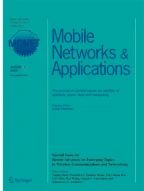Abstract
This paper analyzes several Denial of Service (DoS) attacks at Medium Access Control (MAC) level, with an emphasis on the attacks related to authentication and association mechanisms in WLANs. In particular, a detailed analytical model is presented based on IEEE 802.11e access point (AP) queuing model, which shows the impact of the authentication and association flooding attacks. Using the proposed queuing model, the paper discusses the differences in behavior of APs based on both IEEE 802.11 and IEEE 802.11e standards, under DoS attacks. The analytical model is further extended in order to tackle the 802.11e AP behavior, followed by appropriate quantitative results for different types of Authentication Request Flooding (AuthRF) and Association Request Flooding (AssRF) DoS attacks. More specific, the paper analyzes the AP behavior being under AuthRF DoS attacks with three different levels of attack intensity: Low Level (LL), Medium Level (ML) and High Level (HL), at the same time assuming different traffic priorities. The analysis reveals that during the attack, the implemented algorithm plays a significant role in the overall performance. Namely, if an appropriate model is applied during LL and ML DoS attacks, the high priority traffic will be less affected, providing it with an opportunity to be served with significantly lower losses compared to the low priority traffic. The proposed queuing model and the developed analytical approach can be also used for each protocol layer, especially if the attacks involve flooding with too many requests (ICMP, TCP SYN, UDP etc.). The last part of the paper provides a comprehensive survey of different mechanisms used to mitigate the effects of the DoS attacks on MAC sublayer.
Similar content being viewed by others
Change history
04 February 2017
An erratum to this article has been published.
References
Cisco Systems, Inc. (2011) Cisco wireless control system configuration guide. Softw Release 7:172.0
Egli P (2006) Susceptibility of wireless devices to denial of service attacks. Netmodule, AG
Meiners LF (2009) But…my station is awake! Power save denial of service in 802.11 Networks, Ekoparty’09
Waliullah M, Moniruzzaman ABM, Rahman MS (2015) An experimental study analysis of security attacks at IEEE 802.11 wireless local area network. Int J Futur Gener Commun Netw 8(1):9–18
Wadhwa U (2015) How to perform a DDOS attack on wireless access point. http://www.mightyshouts.com/ddos-attack/, Mighty shouts. 03 Accessed Nov 2015
Fragkiadakis A, Askoxylakis I, Chatziadam P (2014) Denial-of-service attacks in wireless networks using off-the-shelf hardware. In: Lecture notes in computer science, Springer International Publishing, 8530: 427–438
Abdallah AE, Razak SA, Yahaya C (2015) Detection and prevention of denial of service attacks (DoS) in WLANs infrastructure. J Theor Appl Inf Technol 71(3):417–423
Arockiam L, Vani B (2012) Security algorithms to prevent Denial of Service (DoS) attacks in WLAN. Int J Wirel Commun Netw Technol 2:1–7
Liu C, Yu J (2007) A solution to WLAN authentication and association DoS Attacks. IAENG Int J Comput Sci 34:7–14
Liu C, Yu JT (2006) An analysis of dos attacks on wireless LAN, IASTED International Conferences on Wireless Networks and Emerging Technologies (WNET2006). Canada, Banff
Liu C, Yu J (2008) Rogue access point based Denial of Service (DoS) Attacks against 802.11 WLANs, 4th Advanced International Conference on Telecommunications (AICT), Athens, Greece
Liu C, Yu J, Brewster G, (2010) Empirical studies and queuing modeling of denial of service attacks against 802.11 WLANs, IEEE International Symposium on World of Wireless Mobile and Multimedia Networks (WoWMoM), Montreal, Canada
Nguyen TD, Nguyen DHM, Tran BN, Vu H, Mittal N (2008) A lightweight solution for defending against deauthentication/ disassociation attacks on 802.11 Networks. ICCCN 2008
Nguyen TD, Tran BN, Nguyen DHM, (2008) A solution for defending against denial of service attack on wireless LAN. Mobile and wireless networks security. Proceedings of the MWNS 2008 Workshop, Singapore. World Scientific Publishing Co. Pte. Ltd, pp 67–77
Lee YS, Chien HT, Tsai WN (2009) Using random bit authentication to Defend IEEE 802.11 DoS attacks. J Inf Sci Eng - JISE 25(5):1485–1500
LaRoche P, Zincir-Heywood AN (2006) 802.11 De-authentication attack detection using genetic programming, in Proc. EuroGP, pp.1–12
Arockiam L, Vani BA (2011) Comparative study of the available solutions to minimize denial of service attacks in wireless LAN. Int J Comput Technol Appl 2(3):619–625
802.11e-2005 (2005), IEEE standard for information technology--local and metropolitan area networks--Specific requirements--part 11: wireless LAN Medium Access Control (MAC) and Physical Layer (PHY) Specifications - Amendment 8: Medium Access Control (MAC) Quality of Service Enhancements
Tatlas NA, Floros A, Mourjopoulos J (2006) Wireless digital audio delivery analysisand evaluation. IEEE Int Conf Acoust Speech Sig Process 5:201–204
Andrew LLH, Hanly SV, Mukhtar RG (2008) Active queue management for fair resource allocation in wireless networks. IEEE Trans Mob Comput 7(2):231–246
Liu C, Yu J (2009) Detail derivations of Tr, Ta, t2, and t5
Chee-Hock N, Boon-Hee S (2008) Queueing modelling fundamentals with applicationsin communication networks, 2nd edn. John Wiley and Sons Inc., Chichester
Bicakci K, Tavli B (2009) Denial-of-service attacks and countermeasures in IEEE 802.11 wireless networks. Comp Stand Interfaces 31:931–941
Daniel BF, David RC (2006) Detecting identity-based attacks in wireless networksusing signalprints, in Proceedings of the 5th ACM workshop on Wireless security, pp. 43–52
Martinovic I, Zdarsky FA, Wilhelm M, Wegmann C, Schmitt JB (2008) Wireless client puzzles in IEEE 802.11 networks: security by wireless, Proceedings of the first ACM conference on Wireless network security
Author information
Authors and Affiliations
Corresponding author
Additional information
The original version of this article was revised: There was a mistake in the article title. It should read as “Analysis of the Impact of AuthRF and AssRF Attacks on IEEE 802.11e-Based Access Point”.
An erratum to this article is available at https://doi.org/10.1007/s11036-017-0827-8.
Rights and permissions
About this article
Cite this article
Bogdanoski, M., Latkoski, P. & Risteski, A. Analysis of the Impact of AuthRF and AssRF Attacks on IEEE 802.11e-based Access Point. Mobile Netw Appl 22, 834–843 (2017). https://doi.org/10.1007/s11036-016-0753-1
Published:
Issue Date:
DOI: https://doi.org/10.1007/s11036-016-0753-1
